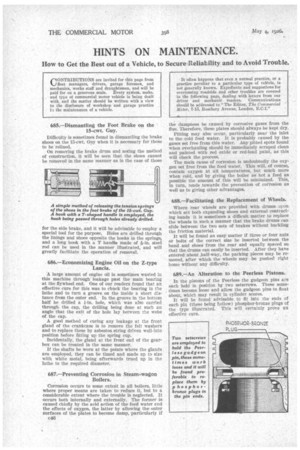HINTS ON MAINTENANCE.
Page 30

If you've noticed an error in this article please click here to report it so we can fix it.
How to Get the Best out of a Vehicle, to Secure Reliability and to Avoid Trouble.
685.—Dismantling the Foot Brake on the 15-cwt. Guy.
Difficulty is sometimes found in dismantling the brake shoes on the 15-cwt. Guy when it is necessary for these to be relined.
On removing the brake drum and noting the method of construction, it will be seen that the shoes cannot be removed in the same manner as in the case of those for the side brake, and it will be advisable to employ a special tool for the purpose. Holes are drilled through the linings and shoes opposite the hooks in the springs, and a long hook with a T handle made of A-in. steel rod can be used in the manner illustrated, and will greatly facilitate the operation of removal.
686.—Economizing Engine Oil on the Z-type Lancia.
A large amount of engine oil is sometimes wasted in this machine through leakage past the main bearing at the flywheel end. One of our readers found that an effective cure for this was to chuck the bearing in the lathe and to turn a groove on the inside a short distance from the outer end. In the groove in the bottom half he drilled a Fin, hole, which was also carried through the cap, the drilling being done at such an angle that the exit of the hole lay between the webs of the cap.
A good method of curing any leakage at the front gland of the crankcase is to remove the felt washers and to replace these by asbestos string driven well. into position before fitting up the spring cup.
Incidentally, the gland at the front end of the gearbox can be treated in the same manner.
If the shafts be worn at the points where the glands are employed, they can be timed and made up to size with white metal, being afterwards trued up in the lathe to the required diameter.
687.—Preventing Corrosion in Steam-wagon Boilers.
Corrosion occurs to some extent in all boilers, little where proper means are taken to reduce it, but to a considerable extent where the trouble is neglected. It occurs both internally and externally. The former is caused chiefly by the acid action of the feed water and the effects of oxygen, the latter by allowing the• outer surfaces of the plates to become damp, particularly if c46
the dampness be caused by corrosive gases from the flue. Therefore, these plates should always be kept dry.
Pitting may also occur, particularly near the inlet to the cold feed water. It is probably caused by the gases set free from this water. Any pitted spots found when overhauling should be immediately scraped clean and painted with red oxide or red-lead paint, as this will check the process.
The main cause of corrosion is undoubtedly the oxygen set free from the feed water. This will, of course, contain oxygen at all temperatures, but much more when cold, and by giving the boiler as hot a feed as possible the amount of this will be minimized. This, in turn, tends ,towards the prevention of corrosion as well as to giving other advantages,
688.—Facilitating the Replacement of Wheels.
Where rear wheels are provided with drums upon which act both expanding shoes and external contracting bands it is sometimes a difficult matter to replace the wheels in such a manner that the brake drums can slide between the two sets of brakes without buckling the friction material. It will be found an easy matter if three or four nuts or bolts of the correct size be inserted between the band and shoes from the rear and equally spaced so that the drums can easily be inserted. After they have entered about ,half-way, the packing pieces may be removed, after which the wheels may be pushed right home without any difficulty.
689.—An Alteration to the Peerless Pistons.
In the pistons of the Peerless the gudgeon pins are each held in position by two setscrews. These sometimes become loose and allow the gudgeon pins to float about, which may result in cylinder scores. It will be found advisable to fit into the ends of each pin (these being hollow) phosphor-bronze plugs of the type illustrated. This will certainly prove an effective cure.
































